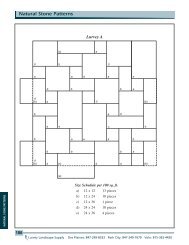Pruning Techniques
Pruning Techniques - Lurvey
Pruning Techniques - Lurvey
- No tags were found...
You also want an ePaper? Increase the reach of your titles
YUMPU automatically turns print PDFs into web optimized ePapers that Google loves.
<strong>Pruning</strong> <strong>Techniques</strong><strong>Pruning</strong> requires care and an interest in how the shrub will look when you aredone. How does it look now? What do you want to achieve with pruning? How doyou want it to look when you are done? Think about these questions and makesure you really know your shrub before you start. Observation will make all thedifference.Use sharp, clean tools so that each cut will be clean and will not tear the branch.Tears, or wounds, will invite insects and increase the potential for infestation.After each shrub, wipe your tools with disinfectant wipes to reduce the possibilityof transferring any disease from one shrub to another in the pruning process.The basic pruning sequence is as follows, for shaping a shrub:Clean up the area around your shrub before you start to remove any debris anddisease. Cut off dead branches as part of this clean-up. Now you can step backand look at your shrub with a pruner’s eye! Look at the structure of the shrub andnote how it grows (individual branches from the ground like forsythia, lateralbranches from a single or multiple trunks like viburnum, etc.)Next follow these steps:1. If you want a more open look to your shrub, remove all criss-crossedbranches on the outside of the shrub at this point. If you want a compactbush, skip this step and go to the next step.2. Use hand shears to head back the branches on the outside of the shrubto the approximate contour you want.
<strong>Pruning</strong> <strong>Techniques</strong> – page 23. Use your loppers or hand saw to thin the shrub. Remove branchesgrowing along the ground and at least one-third of the large, oldbranches in the center of the shrub. These should all be removed atground level.4. Continue thinning by look at the inside of the shrub for other damagedbranches that need to be cut away. You will use your loppers or handshears depending on space and size of the branch.5. Complete thinning by looking carefully inside your shrub and cutting toeliminate criss-crossed branches. When deciding which branch to cut,remove the one that looks least healthy or the one growing in the leasedesirable direction for the growth you want. How you cut will depend ontwo things: the growth pattern of the shrub and the look you want – eitherdense and compact or open.It's critically important to know when to prune. General rules are:Prune early blooming shrubs immediately after they finish blooming:* Azalea & Rhododendron* Lilacs* Serviceberry* MagnoliaShrubs grown primarily for foliage rather than flowers should be pruned inlate winter before growth begins:* Alpine Currant* Dogwood* Burning Bush* Smokebush* Ninebark* HoneysuckleShrubs that can be pruned throughout growing season:* Spirea - After first bloom, will re-bloom* Weigela - After first bloom, will re-bloom* Potentilla - After first bloom, will re-bloom* Rose of Sharon - After first bloom, will re-bloom




